This quick pesto pasta recipe is bright, bold, and packed with flavor. Made with fresh ingredients, this delicious weeknight meal is perfect for summer and ready in just 30 minutes! Vegan-adaptable and gluten-free adaptable.
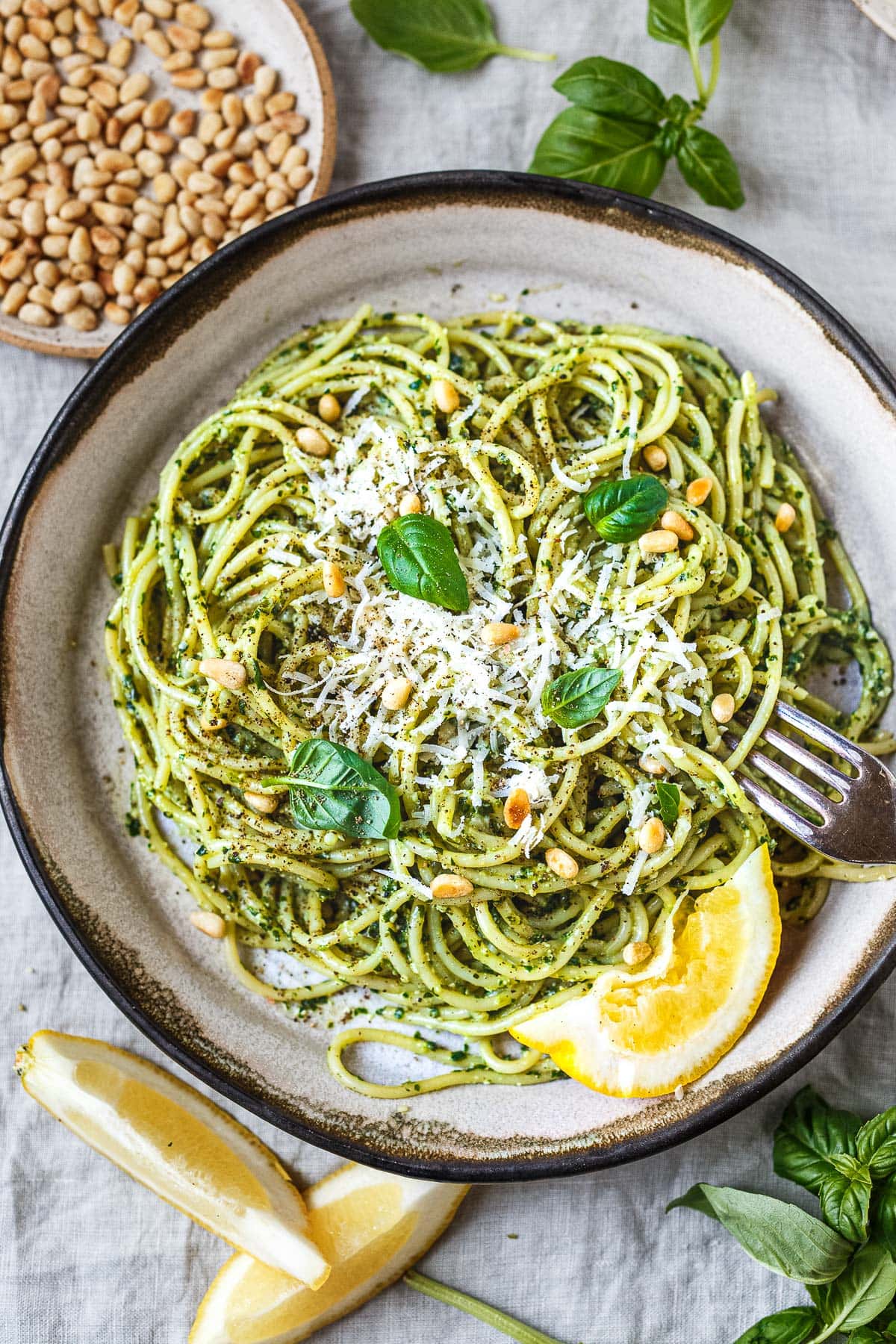
My basil is thriving in the garden this year —a true sign of summer! We’ve been using it in everything lately, and I can’t seem to get enough of it. It smells so… happy.
Here’s a quick and satisfying dinner that’s full of summer flavor- homemade pesto pasta. It’s made with fresh basil, extra-virgin olive oil, Parmesan cheese, garlic, and a touch of lemon. It delivers that classic Italian flair with a bright, modern twist.
Why You’ll Love This Pesto Pasta
What sets our recipe apart? We pack it full of fresh basil for that peppery herby punch. So much better than store-bought pesto! Extra-virgin olive oil and Parmesan cheese impart a savory, umami-rich depth. Fresh garlic brings a zesty kick and a squeeze of lemon, while not traditional, brightens the flavor, enhancing the overall taste.
By incorporating starchy pasta water, we create a creamy, cohesive sauce that clings beautifully to the noodles without becoming heavy or greasy. A simple chef’s trick for a perfectly emulsified sauce.
It’s Adaptable! Keep it vegetarian (or make it vegan or gluten-free) or top it with grilled chicken, shrimp scampi, or chickpeas for a protein-packed meal. Perfect for busy weeknights or dinner parties, this easy pesto pasta is as comforting as it is crave-worthy.
Pesto Pasta Recipe Ingredients
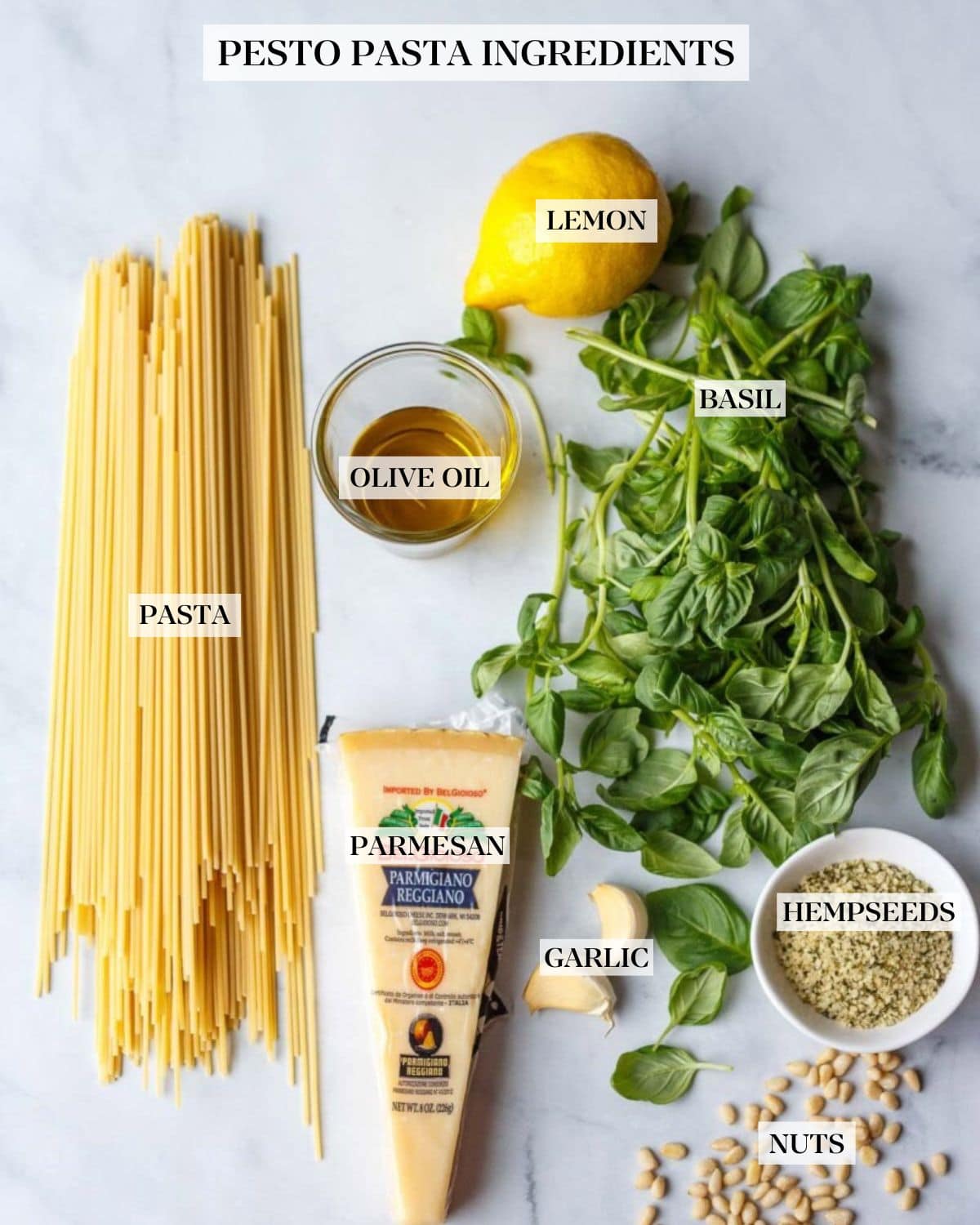
- Fresh Basil: Use fresh basil from your garden or the farmers market! Opt for organic!
- Garlic cloves: Adjust the amount based on your taste preference and the size of the garlic cloves.
- Pine nuts or Hemp seeds: Use hemp seeds for nut-free pesto (very rich and creamy!) or use classic pine nuts, or try walnuts, Brazil nuts, macadamia nuts, smoked almonds, or whatever type of nut you prefer!
- Olive oil: The base of the sauce, for rich and savory flavor. Use a high-quality extra-virgin olive oil.
- Parmesan cheese: For umami depth. You can also sub pecorino.
- Lemon juice: Not traditional, but adds bright, citrusy flavor.
- Pasta: Opt for organic pasta grown in Italy (Less glyphosates=easier digestion) Spaghetti, linguine, or penne pasta are all good choices for tossing with pesto. Gluten-free pasta works too!
- Garnish: Lemon wedges, toasted nuts, grated parmesan, and fresh basil leaves.
Variations
- For extra richness: Add a tablespoon of butter or a splash of heavy cream (more for a creamier sauce) to the hot noodles.
- Add veggies: Roasted carrots, broccoli, cherry tomatoes, zucchini, corn, or spinach all make tasty additions.
- Make it vegan: Use dairy-free, vegan parmesan cheese.
- Add crunch: Top with a sprinkle of Pangrattato (Crispy Italian Breadcrumbs)
- Top with protein: chicken, shrimp,
How to Make The Best Pesto Pasta
1. It starts with the Pesto! In a food processor, combine garlic, nuts, and olive oil. Pulse until the garlic is chopped. Then add Parmesan, lemon juice, salt, pepper, and basil. Pulse to create a textured sauce, but don’t blend it too smooth.
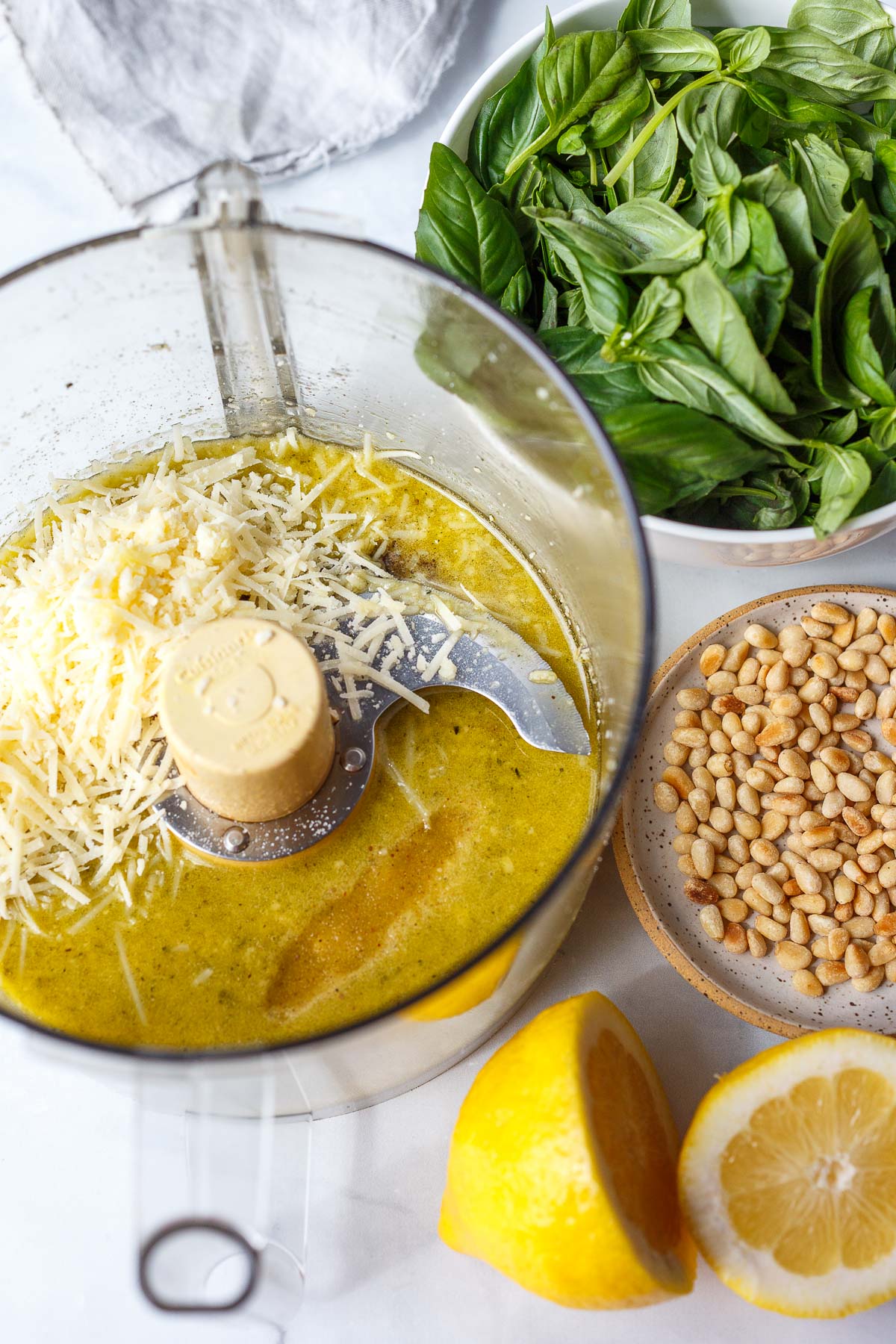
2. Cook the pasta. Boil a large pot of salted water. Cook the pasta until al dente or as per package instructions. Save 1 cup of pasta water, then drain.
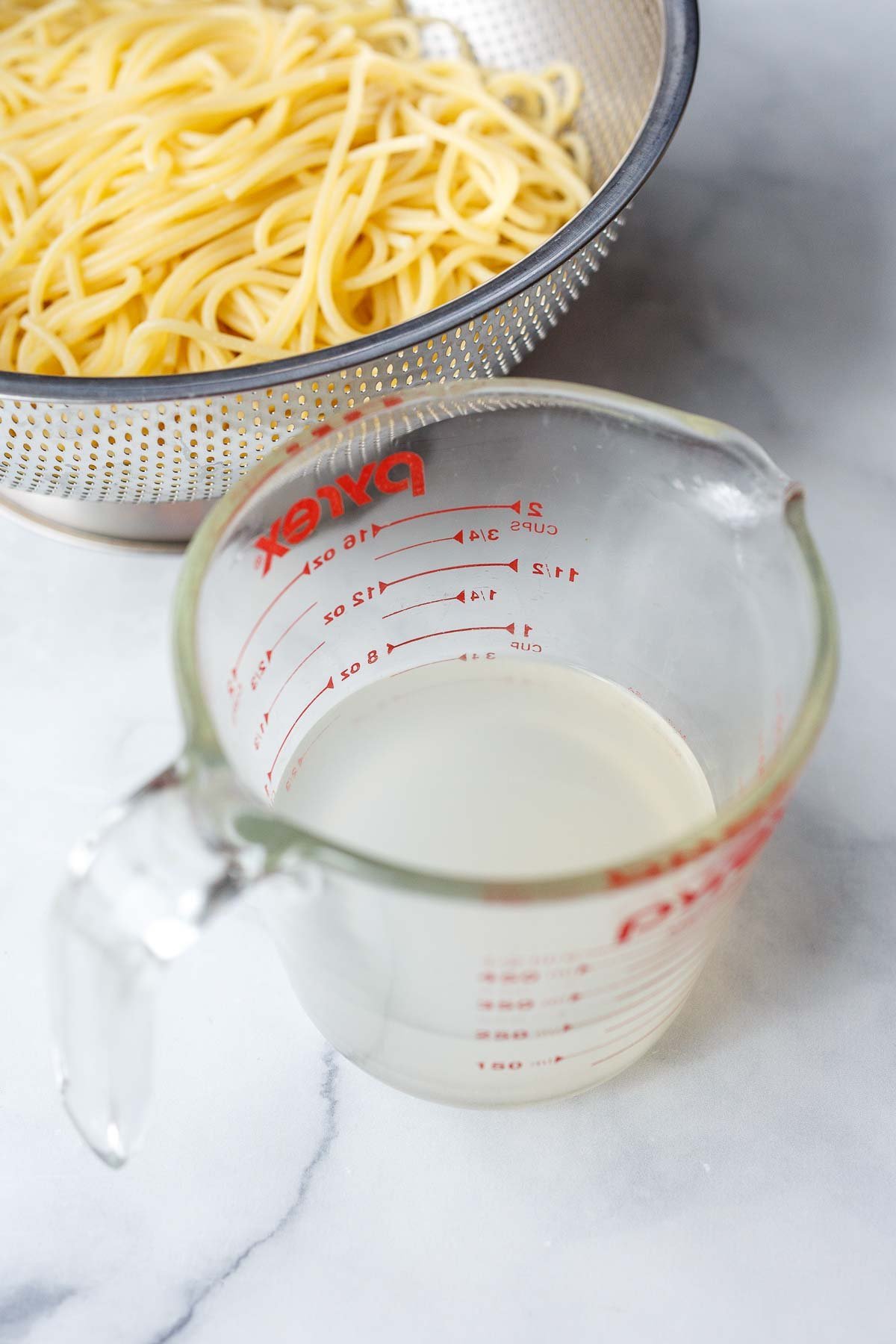
3. Combine. Move the pasta to a bowl (the hot pot can darken the pesto), stir in the pesto sauce and 1/2 cup of pasta water, then toss. Add more pasta water if needed.
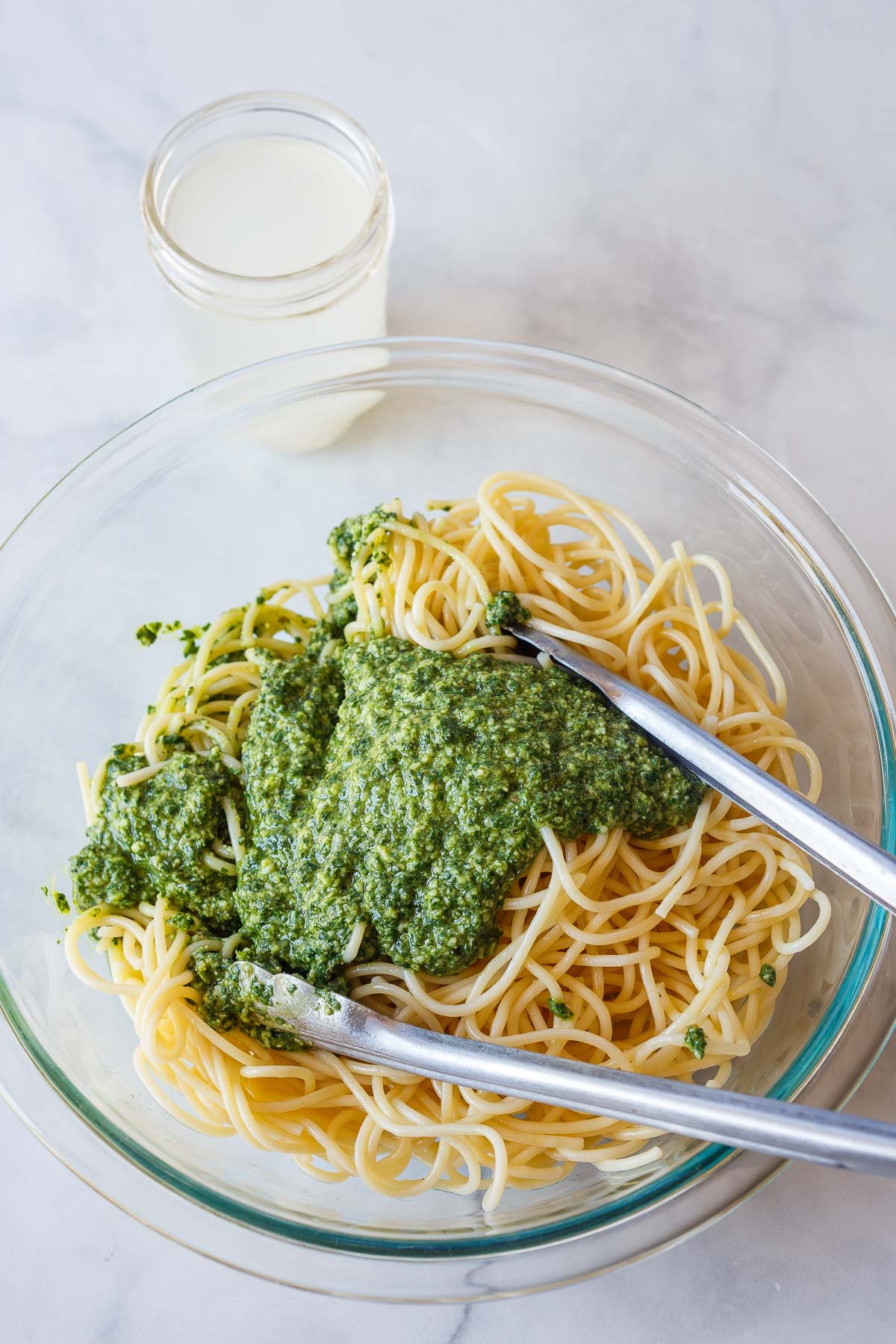
4. Serve. Garnish with lemon wedges, toasted nuts, grated Parmesan, and fresh basil leaves.
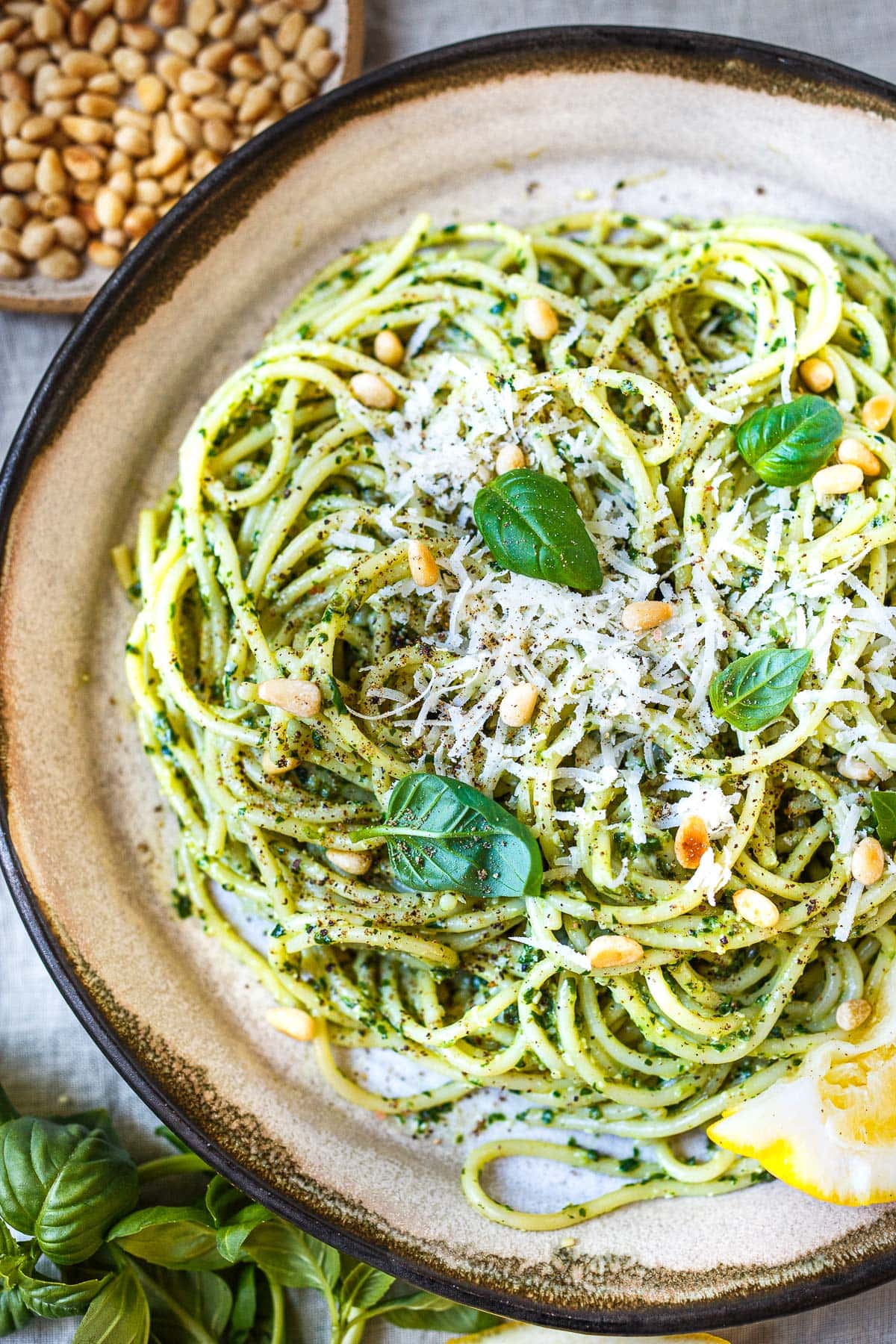
Chef’s Tips
- Pulse, don’t blend: When making the pesto, use a food processor and pulse the ingredients instead of blending them completely smooth. This retains some texture and allows for a more appealing bite.
- Save the hot pasta water! Before draining your pasta, reserve a cup of the starchy water. This helps the sauce stick to the pasta and creates a smooth texture. Adding pasta water to your pesto or noodles also helps achieve the right sauce thickness.
- Add a zing with lemon: A squeeze of fresh lemon juice or zest can brighten the flavors and balance the richness of the pesto.
- Freeze some Pesto: Pesto freezes beautifully. Take advantage of summer’s basil abundance and stock your freezer. It is the best to have a little jar of pesto magic tucked away for winter!
Pasta and Pesto Storage
Leftover pesto: You can freeze it for later. Alternatively, store it in the refrigerator for up to 3-4 days in a jar. Add a drizzle of olive oil on top to prevent oxidation. A small, narrow jar helps keep pesto fresh; it turns dark when exposed to air.
Leftover pesto pasta is delicious hot or cold! Store the pasta in an airtight container in the fridge for up to 4 days.
Serving Suggestions
FAQs
Protein, like grilled chicken or shrimp, chickpeas, or roasted vegetables (carrots, broccoli, zucchini, corn, cherry tomatoes, or spinach) all go well in pesto pasta.
Making pesto pasta is as simple as mixing pasta with the pesto sauce, but we add starchy pasta water to help the pesto sauce stick to the noodles and create a smooth and silky texture.
Top it with toasted pine nuts, grated parmesan, and fresh basil leaves, and serve with lemon wedges. Add a pinch of red pepper flakes for a little heat! You can enhance further with adding roasted veggies and grilled protein.
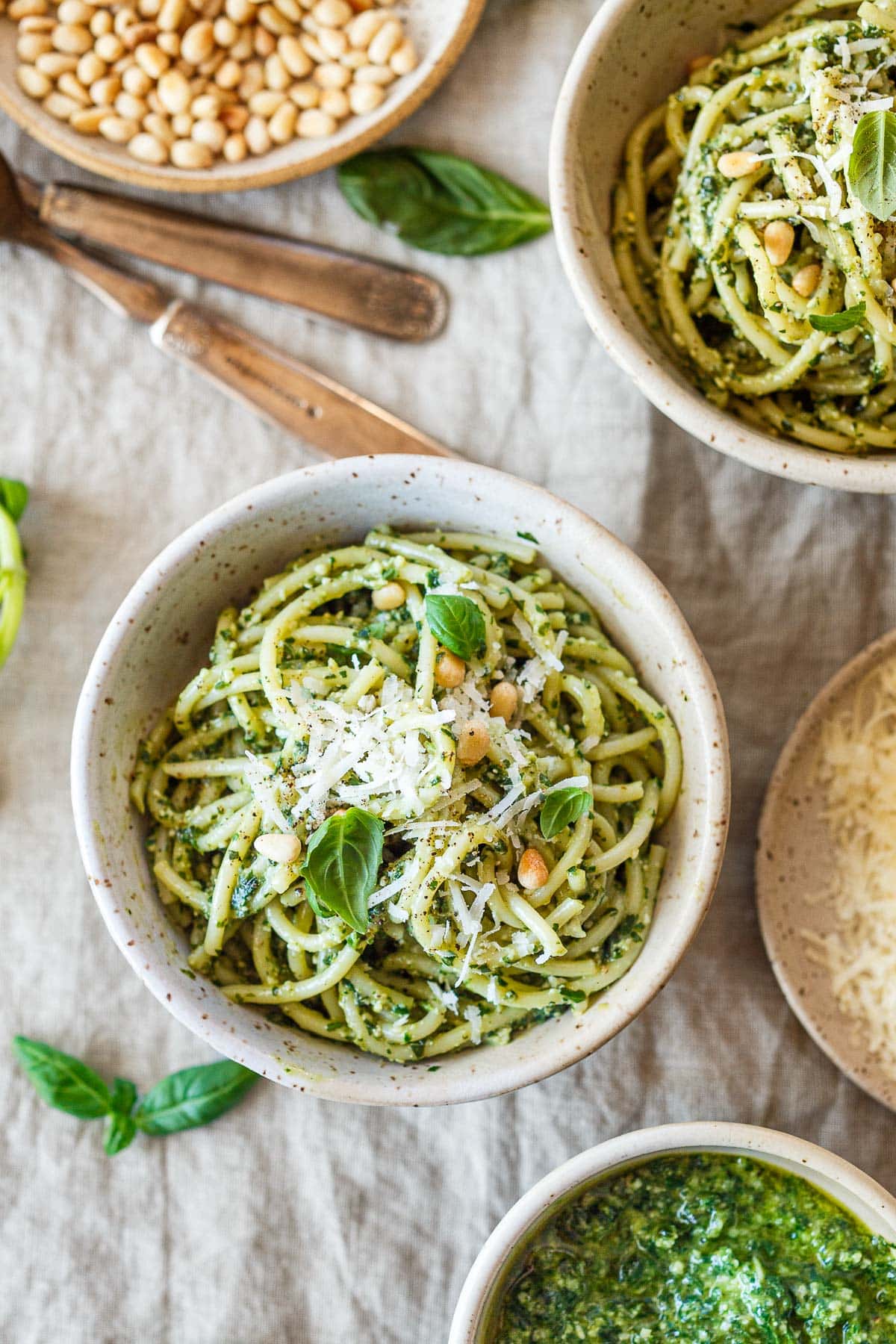
For an easy weeknight dinner, give this pesto pasta recipe a try! Please remember to rate the recipe ⭐️ and leave your adaptations in the comments so others can read them too.
More Favorite Pasta Recipes
Description
This quick pesto pasta recipe is bright, bold, and packed with flavor. Made with simple ingredients, this delicious weeknight meal is perfect for summer and ready in just 30 minutes! We recommend doubling the pasta recipe ( you won’t need to double the pesto) as leftovers are super tasty!
Homemade Pesto
Garnish with lemon zest or wedges, toasted nuts, grated parmesan, and fresh basil leaves.
- Whip up the pesto. In a food processor add garlic, nuts, and olive oil, pulse until garlic is broken down. Add parmesan, lemon juice, salt, pepper and basil leaves. Pulse it to make a textured sauce but not completely smooth.
- Cook the pasta. Boil a large pot of salted water. Cook the pasta to al dente or according to package directions. Before you drain the pasta into a colander, save 1 cup of pasta water. No need to rinse the pasta.
- Mix together. In a bowl (avoid using the hot pasta pot to mix pasta and pesto, the hot pan will turn the pesto dark) combine the cooked pasta with the optional butter, mix to melt. Add pesto sauce and 1/2 cup starchy pasta water toss to combine. Add more pasta water to the mixture if needed.
- Serve with lemon wedges on the side, topped with toasted nuts, grated parmesan, and fresh basil leaves.
Notes
Leftovers can be stored in the refrigerator in an airtight container for up to 4 days.
Leftover Pesto: You can freeze it or store it in the fridge for 3 days (place in a jar and drizzle olive oil over the top, to prevent oxidation). Use it on grilled or roasted veggies or make our pesto pasta salad!
Pesto freezes beautifully. Take advantage of summer’s basil abundance and stock your freezer. It is the best to have a little jar of pesto magic tucked away for winter!
Vegan-adaptable. Use plant-based parmesan and skip the butter!
Veggie additions: roasted carrots, broccoli, cherry tomatoes, zucchini, corn, spinach.
Nutrition
- Serving Size: 1 cup
- Calories: 457
- Sugar: 4.8 g
- Sodium: 257.8 mg
- Fat: 16.9 g
- Saturated Fat: 3.2 g
- Carbohydrates: 61 g
- Fiber: 3.2 g
- Protein: 14 g
- Cholesterol: 0 mg